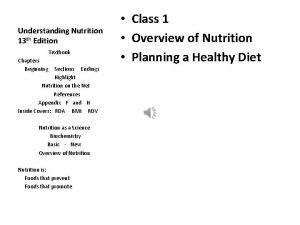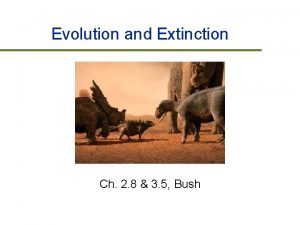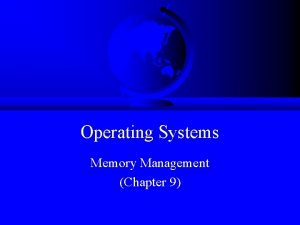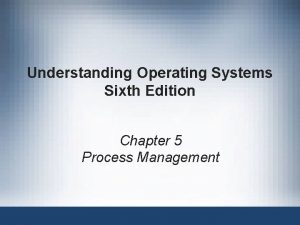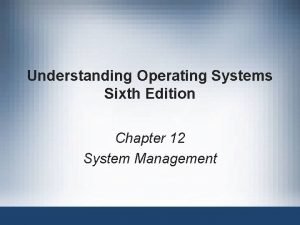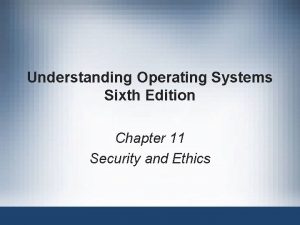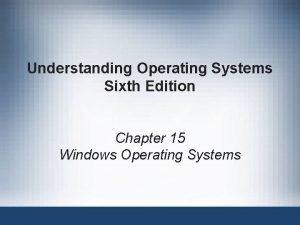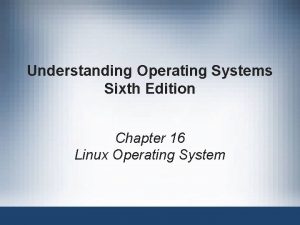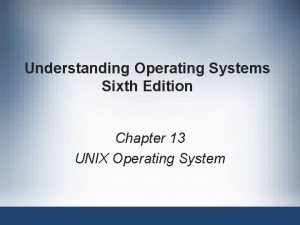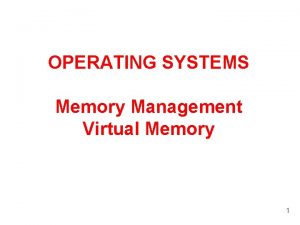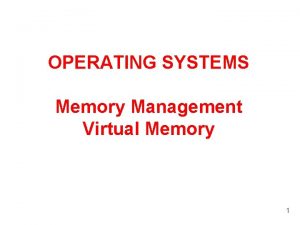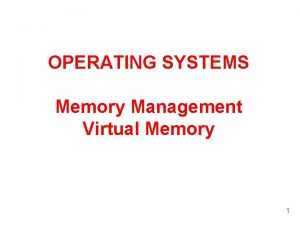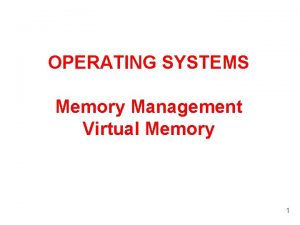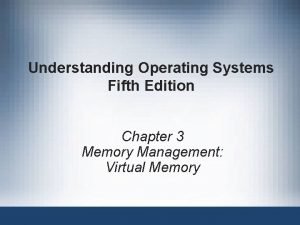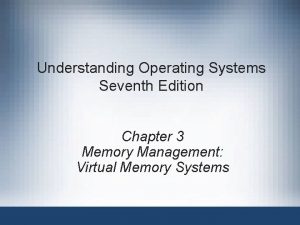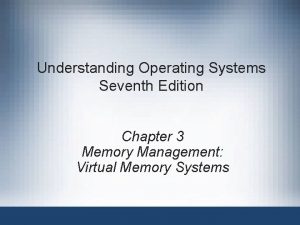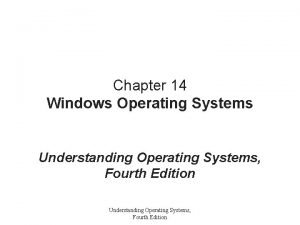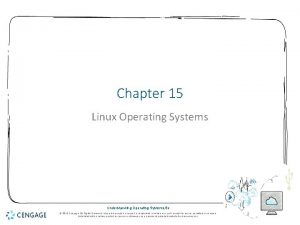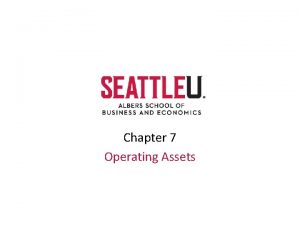Understanding Operating Systems Sixth Edition Chapter 2 Memory















































- Slides: 47

Understanding Operating Systems Sixth Edition Chapter 2 Memory Management: Early Systems

Learning Objectives After completing this chapter, you should be able to describe: • The basic functionality of the three memory allocation schemes presented in this chapter: fixed partitions, dynamic partitions, relocatable dynamic partitions • Best-fit memory allocation as well as first-fit memory allocation schemes • How a memory list keeps track of available memory Understanding Operating Systems, Sixth Edition 2

Learning Objectives (cont'd. ) • The importance of deallocation of memory in a dynamic partition system • The importance of the bounds register in memory allocation schemes • The role of compaction and how it improves memory allocation efficiency Understanding Operating Systems, Sixth Edition 3

Introduction • Management of main memory is critical • Entire system performance dependent on two items – How much memory is available – Optimization of memory during job processing • This chapter introduces: – Memory manager – Four types of memory allocation schemes • • Single-user systems Fixed partitions Dynamic partitions Relocatable dynamic partitions Understanding Operating Systems, Sixth Edition 4

Single-User Contiguous Scheme • • • Commercially available in 1940 s and 1950 s Entire program loaded into memory Contiguous memory space allocated as needed Jobs processed sequentially Memory manager performs minimal work – Register to store the base address – Accumulator to track program size Understanding Operating Systems, Sixth Edition 5

Single-User Contiguous Scheme (cont'd. ) • Disadvantages – No support for multiprogramming or networking – Not cost effective – Program size must be less than memory size to execute Understanding Operating Systems, Sixth Edition 6

Fixed Partitions • Commercially available in 1950 s and 1960 s • Main memory is partitioned – At system startup – One contiguous partition per job • Permits multiprogramming • Partition sizes remain static – Must shut down computer system to reconfigure • Requires: – Protection of the job’s memory space – Matching job size with partition size Understanding Operating Systems, Sixth Edition 7

Fixed Partitions (cont'd. ) • Memory manager allocates memory space to jobs – Uses a table Understanding Operating Systems, Sixth Edition 8

Fixed Partitions (cont'd. ) Understanding Operating Systems, Sixth Edition 9

Fixed Partitions (cont'd. ) • Disadvantages – Requires contiguous loading of entire program – Job allocation method • First available partition with required size – To work well: • All jobs must be same size and memory size known ahead of time – Arbitrary partition size leads to undesired results • Partition too small – Large jobs have longer turnaround time • Partition too large – Memory waste: internal fragmentation Understanding Operating Systems, Sixth Edition 10

Dynamic Partitions • Main memory is partitioned – Jobs given memory requested when loaded – One contiguous partition per job • Job allocation method – First come, first serve allocation method – Memory waste: comparatively small • Disadvantages – Full memory utilization only during loading of first jobs – Subsequent allocation: memory waste • External fragmentation: fragments between blocks Understanding Operating Systems, Sixth Edition 11

Dynamic Partitions (cont'd. ) Understanding Operating Systems, Sixth Edition 12

Best-Fit Versus First-Fit Allocation • Two methods for free space allocation – First-fit memory allocation: first partition fitting the requirements • Leads to fast allocation of memory space – Best-fit memory allocation: smallest partition fitting the requirements • Results in least wasted space • Internal fragmentation reduced, but not eliminated • Fixed and dynamic memory allocation schemes use both methods Understanding Operating Systems, Sixth Edition 13

Best-Fit Versus First-Fit Allocation (cont'd. ) • First-fit memory allocation – Advantage: faster in making allocation – Disadvantage: leads to memory waste • Best-fit memory allocation – Advantage: makes the best use of memory space – Disadvantage: slower in making allocation Understanding Operating Systems, Sixth Edition 14

Best-Fit Versus First-Fit Allocation (cont'd. ) Understanding Operating Systems, Sixth Edition 15

Best-Fit Versus First-Fit Allocation (cont'd. ) Understanding Operating Systems, Sixth Edition 16

Best-Fit Versus First-Fit Allocation (cont'd. ) • Algorithm for first-fit – Assumes memory manager keeps two lists • One for free memory • One for busy memory blocks – Loop compares the size of each job to the size of each memory block • Until a block is found that is large enough to fit the job – Job stored into that block of memory – Memory Manager moves out of the loop • Fetches next job from the entry queue Understanding Operating Systems, Sixth Edition 17

Best-Fit Versus First-Fit Allocation (cont'd. ) • Algorithm for first-fit (cont'd. ): – If entire list searched in vain • Then job is placed into waiting queue • Otherwise, Memory Manager fetches next job – Process repeats Understanding Operating Systems, Sixth Edition 18

Best-Fit Versus First-Fit Allocation (cont'd. ) Understanding Operating Systems, Sixth Edition 19

Best-Fit Versus First-Fit Allocation (cont'd. ) • Algorithm for best-fit – Goal • Find the smallest memory block into which the job will fit – Entire table searched before allocation Understanding Operating Systems, Sixth Edition 20

Best-Fit Versus First-Fit Allocation (cont'd. ) Understanding Operating Systems, Sixth Edition 21

Best-Fit Versus First-Fit Allocation (cont'd. ) • Hypothetical allocation schemes – Next-fit: starts searching from last allocated block, for next available block when a new job arrives – Worst-fit: allocates largest free available block to new job • Opposite of best-fit • Good way to explore theory of memory allocation • Not best choice for an actual system Understanding Operating Systems, Sixth Edition 22

Deallocation • Deallocation: freeing allocated memory space • For fixed-partition system: – Straightforward process – Memory Manager resets the status of job’s memory block to “free” upon job completion – Any code may be used – Example code: binary values with zero indicating free and one indicating busy Understanding Operating Systems, Sixth Edition 23

Deallocation (cont'd. ) • For dynamic-partition system: – Algorithm tries to combine free areas of memory – More complex • Three dynamic partition system cases – Case 1: When the block to be deallocated is adjacent to another free block – Case 2: When the block to be deallocated is between two free blocks – Case 3: When the block to be deallocated is isolated from other free blocks Understanding Operating Systems, Sixth Edition 24

Case 1: Joining Two Free Blocks • Blocks are adjacent • List changes to reflect starting address of the new free block – Example: 7600 - the address of the first instruction of the job that just released this block • Memory block size changes to show its new size for the new free space – Combined total of the two free partitions – Example: (200 + 5) Understanding Operating Systems, Sixth Edition 25

Case 1: Joining Two Free Blocks (cont'd. ) Understanding Operating Systems, Sixth Edition 26

Case 1: Joining Two Free Blocks (cont'd. ) Understanding Operating Systems, Sixth Edition 27

Case 2: Joining Three Free Blocks • Deallocated memory space – Between two free memory blocks • List changes to reflect starting address of new free block – Example: 7560 was smallest beginning address • Sizes of the three free partitions must be combined – Example: (20 + 205) • Combined entry (last of the three) given status of “null” – Example: 7600 Understanding Operating Systems, Sixth Edition 28

Case 2: Joining Three Free Blocks (cont'd. ) Understanding Operating Systems, Sixth Edition 29

Case 2: Joining Three Free Blocks (cont'd. ) Understanding Operating Systems, Sixth Edition 30

Case 3: Deallocating an Isolated Block • Deallocated memory space – Isolated from other free areas • System determines released memory block status – Not adjacent to any free blocks of memory – Between two other busy areas • System searches table for a null entry – Occurs when memory block between two other busy memory blocks is returned to the free list Understanding Operating Systems, Sixth Edition 31

Case 3: Deallocating an Isolated Block (cont'd. ) Understanding Operating Systems, Sixth Edition 32

Case 3: Deallocating an Isolated Block (cont'd. ) Understanding Operating Systems, Sixth Edition 33

Case 3: Deallocating an Isolated Block (cont'd. ) Understanding Operating Systems, Sixth Edition 34

Case 3: Deallocating an Isolated Block (cont'd. ) Understanding Operating Systems, Sixth Edition 35

Relocatable Dynamic Partitions • Memory Manager relocates programs – Gathers together all empty blocks • Compact the empty blocks – Make one block of memory large enough to accommodate some or all of the jobs waiting to get in Understanding Operating Systems, Sixth Edition 36

Relocatable Dynamic Partitions (cont'd. ) • Compaction: reclaiming fragmented sections of memory space – Every program in memory must be relocated • Programs become contiguous – Operating system must distinguish between addresses and data values • Every address adjusted to account for the program’s new location in memory • Data values left alone Understanding Operating Systems, Sixth Edition 37

Relocatable Dynamic Partitions (cont'd. ) Understanding Operating Systems, Sixth Edition 38

Relocatable Dynamic Partitions (cont'd. ) Understanding Operating Systems, Sixth Edition 39

Relocatable Dynamic Partitions (cont'd. ) Understanding Operating Systems, Sixth Edition 40

Relocatable Dynamic Partitions (cont'd. ) Understanding Operating Systems, Sixth Edition 41

Relocatable Dynamic Partitions (cont'd. ) • Compaction issues: – What goes on behind the scenes when relocation and compaction take place? – What keeps track of how far each job has moved from its original storage area? – What lists have to be updated? Understanding Operating Systems, Sixth Edition 42

Relocatable Dynamic Partitions (cont'd. ) • What lists have to be updated? – Free list • Must show the partition for the new block of free memory – Busy list • Must show the new locations for all of the jobs already in process that were relocated – Each job will have a new address • Exception: those already at the lowest memory locations Understanding Operating Systems, Sixth Edition 43

Relocatable Dynamic Partitions (cont'd. ) • Special-purpose registers used for relocation: – Bounds register • Stores highest location accessible by each program – Relocation register • Contains the value that must be added to each address referenced in the program • Must be able to access the correct memory addresses after relocation • If the program is not relocated, “zero” value stored in the program’s relocation register Understanding Operating Systems, Sixth Edition 44

Relocatable Dynamic Partitions (cont'd. ) • Compacting and relocating optimizes use of memory – Improves throughput • Options for timing of compaction: – When a certain percentage of memory is busy – When there are jobs waiting to get in – After a prescribed amount of time has elapsed • Compaction entails more overhead • Goal: optimize processing time and memory use while keeping overhead as low as possible Understanding Operating Systems, Sixth Edition 45

Summary • Four memory management techniques – Single-user systems, fixed partitions, dynamic partitions, and relocatable dynamic partitions • Common requirements of four memory management techniques – Entire program loaded into memory – Contiguous storage – Memory residency until job completed • Each places severe restrictions on job size • Sufficient for first three generations of computers Understanding Operating Systems, Sixth Edition 46

Summary (cont'd. ) • New modern memory management trends in late 1960 s and early 1970 s – Discussed in next chapter – Common characteristics of memory schemes • Programs are not stored in contiguous memory • Not all segments reside in memory during job execution Understanding Operating Systems, Sixth Edition 47
 Peter pickle tongue twister
Peter pickle tongue twister Rubber baby buggy bumpers tongue twister lyrics
Rubber baby buggy bumpers tongue twister lyrics Types of operating system
Types of operating system Modern operating systems 3rd edition
Modern operating systems 3rd edition Structured computer organization
Structured computer organization Biochemistry sixth edition 2007 w.h. freeman and company
Biochemistry sixth edition 2007 w.h. freeman and company Computer architecture a quantitative approach sixth edition
Computer architecture a quantitative approach sixth edition Automotive technology principles diagnosis and service
Automotive technology principles diagnosis and service Automotive technology sixth edition
Automotive technology sixth edition Apa sixth edition
Apa sixth edition Computer architecture a quantitative approach 6th
Computer architecture a quantitative approach 6th Precalculus sixth edition
Precalculus sixth edition Rational people think at the margin
Rational people think at the margin Computer architecture a quantitative approach sixth edition
Computer architecture a quantitative approach sixth edition Understanding human communication 14th edition chapter 1
Understanding human communication 14th edition chapter 1 Business essentials 12th edition
Business essentials 12th edition Understanding nutrition 13th edition rental
Understanding nutrition 13th edition rental Copyright
Copyright Understanding human differences 5th edition
Understanding human differences 5th edition Understanding earth 7th edition
Understanding earth 7th edition Folded mountains
Folded mountains Understanding earth 5th edition
Understanding earth 5th edition Adler and rodman 2006
Adler and rodman 2006 Earth 6th edition
Earth 6th edition Understanding intercultural communication 2nd edition
Understanding intercultural communication 2nd edition Using mis (10th edition) 10th edition
Using mis (10th edition) 10th edition Using mis 10th edition
Using mis 10th edition Operating system
Operating system Operating system concepts 6th edition
Operating system concepts 6th edition Modes of speciation ppt
Modes of speciation ppt Virtual memory in os
Virtual memory in os Single partition allocation
Single partition allocation Address binding
Address binding Semantic memory example
Semantic memory example Excplicit memory
Excplicit memory Long term memory vs short term memory
Long term memory vs short term memory Internal memory and external memory
Internal memory and external memory Primary memory and secondary memory
Primary memory and secondary memory Logical address
Logical address Which memory is the actual working memory?
Which memory is the actual working memory? Virtual memory
Virtual memory Virtual memory in memory hierarchy consists of
Virtual memory in memory hierarchy consists of Eidetic memory vs iconic memory
Eidetic memory vs iconic memory Shared vs distributed memory
Shared vs distributed memory Understanding experience in interactive systems
Understanding experience in interactive systems Understanding distributed systems roberto vitillo
Understanding distributed systems roberto vitillo Principles of electronic communication systems 3rd edition
Principles of electronic communication systems 3rd edition Modern system analysis and design
Modern system analysis and design
















